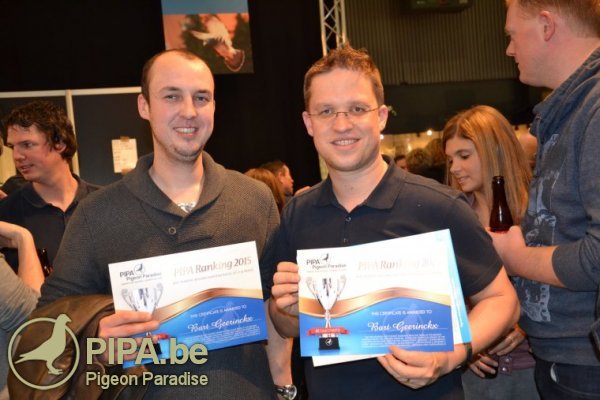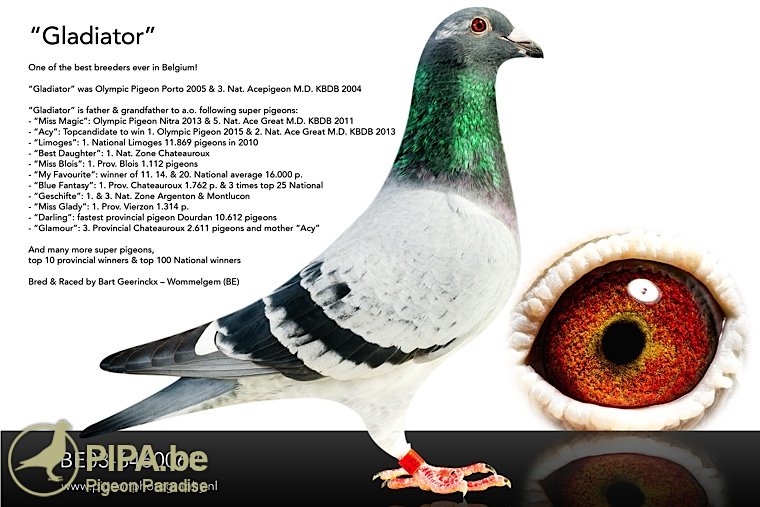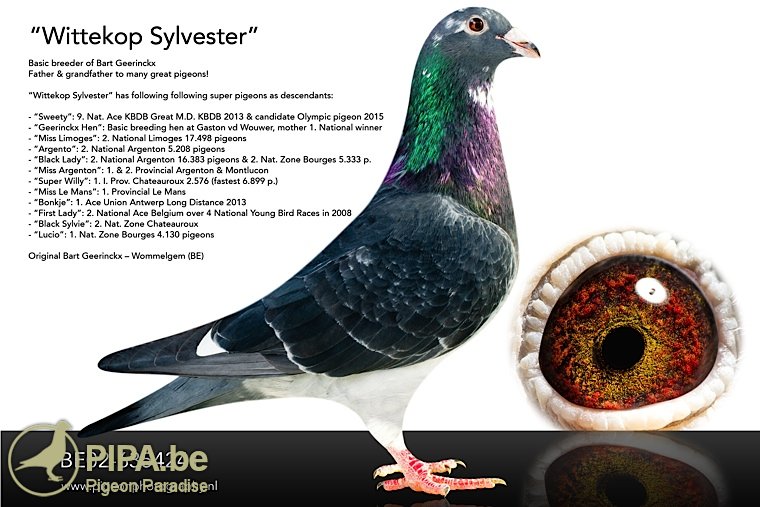 Bart Geerinckx and Nikolaas Gyselbrecht showing the certificates for the first prizes in the PIPA rankings
Bart Geerinckx and Nikolaas Gyselbrecht showing the certificates for the first prizes in the PIPA rankings
Recovery and training, two important topics
PIPA: The hens start their widowhood when the middle distance gets under way. Do you show their cocks before the race?
Bart: Definitely not in the beginning. It can be a useful strategy if you want to increase their motivation for the most important races, for instance for the classics from Bourges and Châteauroux. I intend to prepare a racing team for Limoges, Jarnac, Brive and/or Tulle as well, and for them some additional motivation can prove very useful.
PIPA: How long can the partners stay together after the race?
Bart: Not too long in the first few races. As for the national races a lot depends on the time of arrival and the difficulty of the race. If they have had a very tough race I tend to take away the cocks fairly soon. I read that many fanciers keep the male and female together until the next morning. Well, I do just the opposite.
PIPA: Why?
Bart: Because the pigeons have to recover more quickly after a tough race, and I think they should first of all get some rest. During the week I will sometimes give them an additional portion of feed after a training flight, and they can then spend some more time with their hen as well. Or they can sit together a little longer before being basketed. I will only let them spend a night together towards the end of the season, for instance after a long distance race.
PIPA: What is your approach for the cocks?
Bart: Let me start by saying that I have been making quite a few adjustments in the cocks’ loft, especially in terms of natural light. There is a lot more (sun)light in the loft now, which improves the overall climate. It appears that the racing cocks need a lot of extra warmth to get in top form. The hens are less sensitive.
PIPA: Do the cocks raise a youngster just before the season as well?
Bart: No, not at all. They were paired in early February and they were allowed to overbrood. They have been in widowhood since the beginning of March, so where no longer paired. But I would sometimes let them stay with their hen for an entire day after a training flight. We used to keep them together for three days straight twice during the season but that was not a successful approach. The yearlings were not enough attached to their own box.
PIPA: Can the cocks see their hens before they are basketed?
Bart: Usually not. We sometimes show the hens to allow the racing cocks to get in peak form, but it is no gurantee. We will sometimes take the cocks away for a midweek training flight, and then they get to see their hens for half an hour. But this is not common practice.
PIPA: When or why do you take the pigeons away for a training flight?
Bart: We sometimes do it in changing weather conditions. For instance, if they have had two flights with a strong headwind and we expect a tailwind for the next few days, we will sometimes basket them for a training flight during the week, so they get used to the tailwind. This is a matter of common sense, and a way of anticpating the changing weather conditions.
PIPA: What does the training at home look like during the week?
Bart: I think training is the foundation for everything. You cannot win prizes if you don’t train! We do not use a fixed training scheme however, since training depends on the weather and on last weekend’s race. You have to try and understand how fit your pigeons are. This is one of the challenges of keeping pigeons: trying to understand what your pigeons really need.
PIPA: But we assume you have at least some guidelines?
Bart: That is right. We will usually increase the training load for two weeks leading up to the national classics. This is when the pigeons do two training flights per day if the weather is not too cold in the morning. We do this to get them into a solid rhythm.
If they do a national race almost every week they will usually come by with one good training each day. After an easy race or an intermediate race (over a shorter distance) we sometimes organise two training flights a day anyway. The pigeons get a lot of feed in this time of the season, so they have to train hard not to gain any weight. And hard training requires an adequate diet.
PIPA: Quite a lot has changed in terms of feed and recovery in recent years. Is this also the case for the Geerinckx pigeons?
Bart: You are right. Many years ago one could still win an early prize 15 minutes after the winner. Those days are over now. We have seen a lot of changes especially in terms of recovery, which is an evolution we see across many sports. The racing birds look all fresh one day after a hard race, because they recover more quickly. They are back in training by Monday, while years ago it would take them three to four days to get back on their feet after a race, depending on the distance and the racing conditions. Pigeons were raced no more than once every two weeks. Today many fanciers basket their pigeons on a weekly basis, even for the long distance. As a fancier you have to create a racing team that can cope with this.
PIPA: Very true. We also noticed in recent seasons that many fanciers would basket their pigeons for three or even four consecutive long distance races (Limoges, Jarnac, Brive, and Tulle). Do you understand why some fanciers have mixed feelings about this?
Bart: Yes, but some pioneers have successfully managed to do this. This is also thanks to better recovery and an improved diet, based on different mixtures and a more balanced fat intake.
PIPA: So Bart Geerinckx wanted to learn more about this as well?
Bart: Of course. Diet and recovery are the key words here. Both have to be in line with the upcoming race and the racing conditions. Everything has to be taken into account to come full circle.
PIPA: What does recovery look like for the Geerinckx pigeons?
Bart: We use mainly products of Röhnfried, sometimes alternated with Backs products. Our pigeons can recover more quickly with the help of protein powders on Saturdays and Sundays. During the season the pigeons hardly get any vitamins; they get these mainly in the autumn, when they are weaning, or in the breeding period (only for the breeding pigeons). In addition, we add different oils to the feed in the first few days after a race.
PIPA: And then you get ready for the next race?
Bart: Yes, then we mainly use a combination of different products. That does not mean we use a different product every single day. We try to get the most out of a given product by using it for an entire week. We use for instance Avifarm, especially in hot temperatures, or one week of Blitzform, or one week with beet juice. This is done on feel during the season.
PIPA: And what about their diet?
Bart: We use mainly Matador mixtures. They get a start mixture before the season, but when the season is underway we only use this mixture during rest weeks, in which the hens complete a 100km race (Quiévrain). During these weeks we give them sedochol throughout the week, combined with a few days of start mixture.
When we increase the portions of feed to prepare for a race we always assume that they have a very difficult flight ahead, and we want to make sure they have a lot of energy. So they get some additional fats in the form of a Turbo Mixture, peanuts and walnuts.
PIPA: What does their diet look like during the week?
Bart: Easily digestible food is very important for a pigeon. They get a Turbo mixture when they get home, often combined with Kweek mixture. On Sundays they get a 50% Superdiet and a 50% Racing Mixture. On Mondays and Tuesdays they get a limited portion of Racing and Turbo Mixture. They can eat as much as they want for 30 minutes on Wednesdays and Thursdays, with a higher percentage of Turbo (sometimes they only get Turbo). After those thirty minutes they can eat some peanuts and walnuts as well.
PIPA: Health is of crucial importance for pigeons that get basketed every week. What is your take on this?
Bart: We only use medications on the advice of our veterinary surgeon. We do give a one week treatment for tricho before the start of the season, as well as a broad spectrum antibiotics cure in January. We have only been using this antibiotics cure for a few seasons. The reason is that some of our racing birds had been lost for several days after the disastrous race from Châteauroux (August 2015). We have no idea where they have been, what they have been drinking and what germs they might be carrying. We are trying to get rid of any germs with a one-week cure in January.
PIPA: Do you disinfect the pigeons after a race? Your hands seem to indicate something…
Bart: Yes, well spotted. The pigeons were administered yellow drops just before you arrived. This is quite a difficult job to do on your own, and the yellow colour is difficult to wash off. I think these yellow drops are an excellent disinfectant. It is no form of medication, it does not make them resistant and it does not negatively influence their fitness either. They get yellow drops every time they are basketed for two consecutive nights. After a particularly difficult race or a rainy flight they get drops when they get home as well.
PIPA: And what do you do against possible head diseases?
Bart: We only use medication against head diseases if it is really necessary. I try to avoid this as long as possible. I do believe the yellow drops have a positive effect as well, because they act as a disinfectant.
PIPA: Do you darken and/or lighten your old and young birds?
Bart: We do not compete in the national races for young birds, so darkening or lightening would not be very useful for them. The old birds are not darkened either but they are lightened from early July, just to maintain their level of fitness for the last few races.
PIPA: You won a national ace pigeon title with Little Star in 2015. Do you have a possible successor in mind?
Bart: Little Star was placed in the breeding loft right away, so it will be up to the others to follow in his footsteps, and to aim for an ace pigeon or Olympiad title. We have to wait and see what happens during the season. There are so many factors that influence the outcome of a season, and nobody can predict the future.
PIPA: Luck plays a big role as well.
Bart: My favourite races are the Belgian national flights, where the competitors are divided across the country. The pigeons have to learn how to pull away from the group, and how to tackle certain parts of the course on their own or in smaller groups. This is what makes a Belgian racing bird so valuable. They have an improved sense of orientation, and that is what we look for in our pigeons!
PIPA: But don’t you need a bit of luck to win a first prize as well?
Bart: That is right. The location, the flight direction and most of all the wind will dictate the outcome of a national race. Still, I think many fanciers should start to realise that everything begins at club level. You have to learn how to win first prizes in your own club first, where the conditions are more or less similar for all participants. You should only aim for more after you win a first prize at club level. You can then start to aim for more if the conditions allow, starting at provincial or zonal level, and only then national level.
PIPA: Sounds like a reasonable approach. Still, as a fancier you cannot control everything.
Bart: I know, I am aware of that. As a fancier you have to accept that things can go wrong sometimes. Every loft has to deal with setbacks once in a while, for instance birds of prey, a disastrous race or pigeons that get wounded or killed. It is all part of the job. We all try to breed that one super class pigeon that everyone talks about. And when something goes wrong with your most precious pigeon, it can be quite hard blow.
PIPA: It can be hard to accept mentally.
Bart: I agree. Pigeon racing at the highest level is about working hard every single day. But you also have to understand that things can go wrong one day. A disastrous race for instance can happen any day. That is why race organisers should assume their responsibilities. During a release they should at least make sure that all pigeons will be able to get home safely.
PIPA: And then it’s up to the pigeons to show what they are capable of.
Bart: Look, it takes super class pigeons to win an early prize every single week. But you need to make sure these pigeons are in peak form, which means they have to be well looked after, otherwise you will not get anywhere. It is often a matter of details. It is up to the fancier to find any imperfections and to make the necessary adjustments.
PIPA: Bart, we wish you a successful 2016! Thank you for a very interesting conversation.


